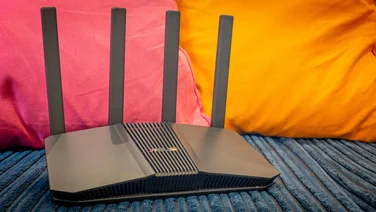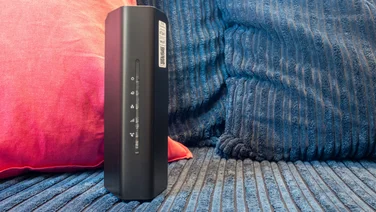To help us provide you with free impartial advice, we may earn a commission if you buy through links on our site. Learn more

- Game-oriented DumaOS platform
- Regular router duties are well covered, too
- Reasonable price for a gaming router
- Unexceptional wireless performance
- No support for top-speed Wi-Fi 6E
Many routers are designed to share their wireless bandwidth as fairly as possible across a wide spread of devices. But gamers want the opposite: when you’re in the middle of a fast, competitive online tournament, you don’t need phones and smart TVs slowing down your connection.
That’s why the Netgear Nighthawk XR1000 doesn’t use the company’s standard router firmware. Instead, it runs the custom DumaOS, independently designed to give gamers full control over which devices get priority on their networks, and help to hook them up to the fastest gaming servers.
While the XR1000 is the first Netgear gaming router we’ve seen that supports Wi-Fi 6, it isn’t the fastest router on the block. However, if you’re looking for a smooth and speedy gaming experience on a mid-range budget, it’s a persuasive choice.
Netgear Nighthawk XR1000 review: What you need to know
The Nighthawk XR1000 is a standalone dual-band router. It claims connection speeds of up to 600Mbits/sec on the 2.4GHz radio band and a massive 4.8Gbits/sec for 5GHz connections – achieved by making use of 4×4 MU-MIMO, and channel widths up to the maximum 160MHz.
The XR1000 can’t take advantage of the less congested 6GHz radio band however, as it doesn’t work with Wi-Fi 6E. And while there are four gigabit LAN ports at the back, there’s no support for the increasingly popular 2.5GbE standard. If you want the very latest and fastest technologies, you’ll need to look elsewhere.

Netgear Nighthawk XR1000 review: Price and competition
At £244, the price of the Nighthawk XR1000 is pretty reasonable for a Wi-Fi 6 gaming router. It’s some way from the cheapest we’ve reviewed, however: that honour goes to the Asus TUF Gaming AX5400, which you can buy online for just £134. While the Asus doesn’t match the gamer-specific functions of the Nighthawk, it offers some simple traffic-management features for prioritising your gaming connection, and – as we’ll see below – its overall performance compares quite well with the Nighthawk’s.
If you’re willing to spend more, the Asus ROG Rapture GT-AX6000 is also worth a look. We’ve found it impressively fast over both wired and wireless connections, and Asus’ “Republic of Gamers” firmware has plenty of features to tinker with. It’s a substantial step up in price from the Netgear, however, at £328. Another option at a similar price is the £339 TP-Link Archer AX11000.
At the top of the range, the Asus ROG Rapture GT-AXE11000 comes with the same gaming capabilities as the GT-AX6000 and adds Wi-Fi 6E. It’s a whopping £480, though, and I found it didn’t wring the best performance from a Wi-Fi 6E connection.
Indeed, if performance is a priority, your best bet might be to invest in a non-gaming router, and use custom QoS settings to prioritise your gaming connection. The fastest router we’ve tested is the Netgear Nighthawk RAXE500, which again offers both Wi-Fi 6E and 2.5GbE – along with a tremendous £550 price tag. The Netgear Nighthawk RAXE300 isn’t far behind in terms of speed, and costs a more reasonable £350.

Netgear Nighthawk XR1000 review: Design and features
The Nighthawk XR1000 looks quite stylish, with a subtly speckled black trim and dark red meshing at the top and front. Its angular design is substantial but not over-large, measuring 200mm deep and extending to a maximum width of 295mm, not counting the antennae that stick out of the sides. On the top, eight LEDs show network activity, and two push-buttons let you quickly enable WPS pairing and turn the Wi-Fi transmitter on and off.
As I’ve mentioned, there are four gigabit Ethernet ports at the rear, plus a fifth port that connects to your internet modem. There’s also a single USB 3 socket, which you can use to share files and media over your network. As usual with Netgear, however, it won’t take a printer, nor a mobile internet adapter.
Getting set up with the Nighthawk mobile app is a piece of cake. You scan the sticker on the front of the router with your phone camera, then step through the connection instructions. After this, you can use the app for basic network-management tasks, such as tweaking Wi-Fi settings and browsing connected devices. The app also includes Netgear’s powerful wireless scanning tool, for checking your signal strength and surveying nearby networks.
For the main attraction though you’ll need to connect from a desktop browser. This brings up the DumaOS dashboard, which by default comprises six small, interactive panels showing various network statistics and functions. These can be freely dragged around and resized as you wish and, as you click around other pages of the interface, you’ll find plenty of other dynamic controls you can add to the dashboard by clicking the pin icon.
Signature gaming features include the Ping Heatmap and the Geo-Filter. The former polls all known servers for a selected game, and tests their ping times to identify which will be the most responsive. There are 18 preconfigured titles and platforms to choose from, including CS:GO, FIFA 23, Fortnite and PUBG, plus Nvidia’s GeForce Now service. The Geo-Filter can then be used to automatically block servers that are too far away or too slow, preventing games from connecting you to them.

Beyond this, numerous “Rapps” (router apps) can improve gaming performance in other ways. The graphical QoS tool lets you set relative bandwidth allocations for online activities, or give top priority to recognised games. The Network Monitor page shows which devices are using what share of bandwidth, and breaks down the total traffic by type. And, if you don’t like what you see, you can use the Traffic Controller to block individual devices between certain times, or restrict them to specific ports, applications or connection types.
Additional features include a router-side ad blocker and a network benchmark tool. And under Router Settings you’ll find all the same administration controls as on regular Nighthawk routers. These let you perform advanced Wi-Fi configuration, set up DHCP and port forwarding options and even enable an incoming VPN server for secure access to your home LAN.
What’s notably lacking is a proper parental control module – you can only do simple scheduling and blocking of specific sites and services – although, to be fair, this router probably isn’t aimed at parents. And, as usual with Netgear, network security is an optional extra. There’s a 30-day trial of Netgear Armor included, after which it costs £34 for the first year and £85 per annum after that.
Netgear Nighthawk XR1000 review: Performance
To test the Nighthawk XR1000’s wireless performance I set up the router in my study at home, and connected it directly to my internet line. An Asustor Drivestor 4 Pro NAS appliance was connected to one of the four gigabit Ethernet ports.
I then grabbed my standard test laptop (equipped with an Intel AX210 2×2 Wi-Fi card), took it to various rooms in my house, connected to the Nighthawk’s 5GHz network and copied a set of 100MB files to and from the NAS.
Here are the average upload and download speeds I saw, along with figures from a selection of other routers for comparison:


It’s not a particularly distinguished performance. The XR1000’s download speeds were no faster than those of the much cheaper Asus AX5400. And when you compare the Nighthawk to the pricier Rapture GT-AX6000, the Asus wins in almost every location, only falling behind in the bedroom.
There’s an even bigger performance gap between the XR1000 and Netgear’s 6E-capable routers. That’s not surprising, since they use newer technology and are considerably more expensive. Even so, if you’re looking for extreme performance, the difference in download speeds might be an eye-opener.
Don’t let this turn you off the Nighthawk XR1000 too much, though. It’s absolutely fast enough for gaming and household Wi-Fi duties. It just doesn’t deliver anything special compared to the competition. Power consumption is unexceptional, too: I measured an idle draw of 9.4W, rising to 11.9W in the thick of my performance tests.
Netgear Nighthawk XR1000 review: Verdict
The Nighthawk XR1000 is certainly a distinctive proposition. The custom DumaOS firmware offers more flexible gaming and traffic-management options than any other router we’ve tested, and the customisable graphical interface is undeniably nifty. The hardware is attractive, too.
Performance might be a sticking point. While the XR1000 isn’t exactly outdated, it doesn’t embrace the latest Wi-Fi technology, nor does it follow the trend towards multi-gigabit Ethernet.
Even so, there’s ample bandwidth to support a high-speed server connection, or a local LAN party – and skipping out on the latest networking technologies helps keep the price down. Gamers on a budget will find Asus’ TUF Gaming AX5400 better value but the XR1000’s top-flight server and traffic controls certainly make it an attractive alternative.







